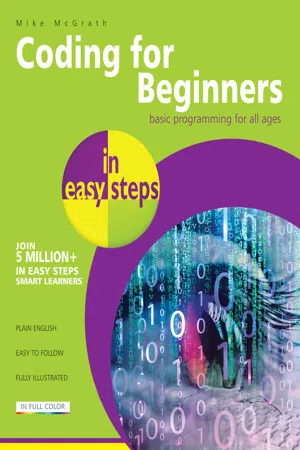
- English
- ePUB (mobile friendly)
- Available on iOS & Android
Coding for Beginners in easy steps
About This Book
Coding for Beginners in easy steps has an easy-to-follow style that will appeal to anyone, of any age, who wants to begin coding computer programs. You need have no previous knowledge of any computer programming language so it's ideal for the newcomer, including youngsters needing to learn programming basics for the school curriculum.The book instructs you how to write code to create your own computer programs. It contains separate chapters demonstrating how to store information in data structures, how to control program flow using control structures, and how to create re-usable blocks of code in program functions. There are complete step-by-step example programs that demonstrate each aspect of coding, together with screenshots that illustrate the actual output when each program has been executed. Coding for Beginners in easy steps begins by explaining how to easily create a programming environment on your own computer, so you can quickly begin to create your own working programs by copying the book's examples. The examples throughout this book feature the popular Python programming language but additionally the final chapter demonstrates a comparison example in the C, C++, and Java programming languages to give you a rounded view of computer coding.
Frequently asked questions
Information

Table of contents
- Cover
- Title
- Copyright
- Contents
- Preface
- 1 Getting started
- 2 Saving data
- 3 Performing operations
- 4 Making lists
- 5 Controlling blocks
- 6 Creating functions
- 7 Sorting algorithms
- 8 Importing libraries
- 9 Managing text
- 10 Programming objects
- 11 Building interfaces
- 12 Developing apps
- 13 Transferring skills
- Back Cover